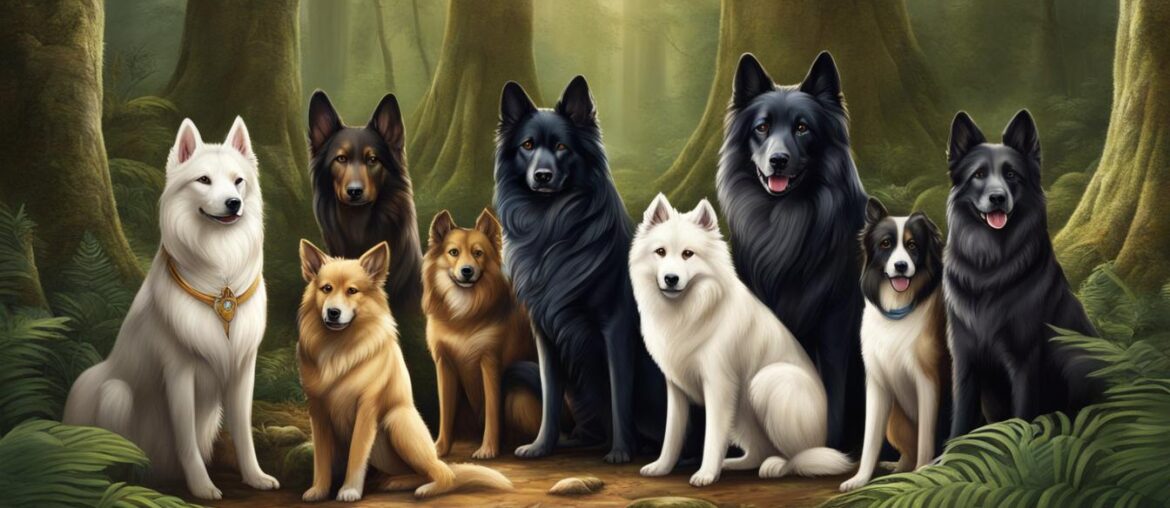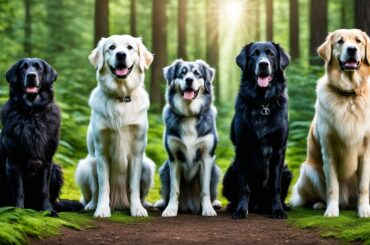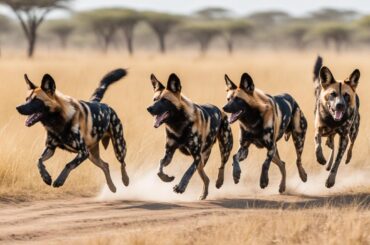Dogs have been our loyal companions for thousands of years, and within the vast and diverse canine kingdom, there exist extraordinary breeds that have a significant historical legacy. These ancient dog breeds, also known as primitive breeds, provide a fascinating glimpse into the past and possess unique qualities that set them apart from more modern counterparts.
Ancient dog breeds are rare gems, hailing from different corners of the globe and tracing their origins back centuries. They embody a living connection to our shared history, offering insight into the remarkable bond between humans and canines throughout time. These breeds, such as the Basenji, Shiba Inu, Saluki, and Akita, have remained relatively unchanged through the generations, preserving their distinctive traits and ancient allure.
Key Takeaways:
- Ancient dog breeds have a rich historical background and maintain their ancient origins.
- These rare and unique dog breeds include the Basenji, Shiba Inu, Saluki, and Akita.
- They provide a glimpse into the long-standing bond between humans and canines.
- These breeds have preserved their ancient characteristics and charm.
- Exploring ancient dog breeds offers a fascinating window into our shared history.
Ancient Dog Breeds and Their Origins
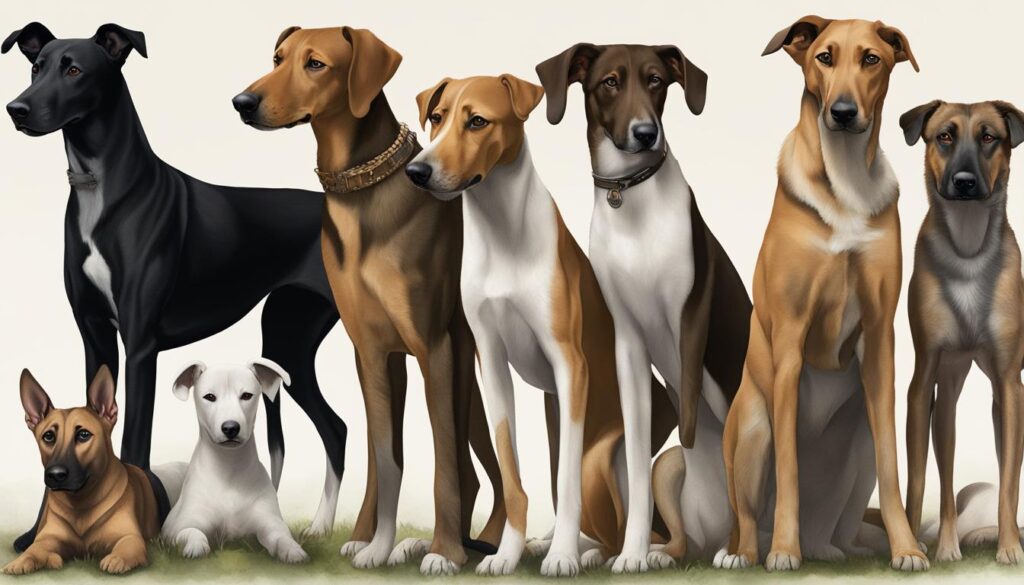
Ancient dog breeds, often referred to as primitive breeds, have a fascinating history that spans thousands of years. These breeds have remained relatively unchanged through selective breeding, preserving their ancient characteristics and unique qualities. Let’s explore some notable ancient dog breeds and their origins.
Basenji
The Basenji is an ancient breed believed to have originated in Central Africa. Known as the “barkless dog,” it produces unique vocalizations more similar to yodeling or howling than traditional barking. Basenjis were highly valued by African tribes for their hunting skills and ability to navigate dense forests.
Shiba Inu
The Shiba Inu is one of Japan’s oldest and smallest native breeds. With a spirited personality and keen hunting instincts, it was originally bred for small game hunting in Japan’s mountainous regions. Today, it is a beloved companion dog both in its homeland and around the world.
Saluki
The Saluki, also known as the Persian Greyhound, is one of the oldest known dog breeds. It has a rich history in the Middle East, where it was treasured by Bedouin tribes for its hunting prowess and loyalty. Salukis are renowned for their grace, speed, and elegant appearance.
Akita
The Akita is a dignified and powerful breed with roots in Japan’s mountainous regions. Originally used for hunting large game, such as bears and boars, the Akita also served as a loyal and protective companion to Japanese royalty. Today, it is loved for its loyalty, intelligence, and striking appearance.
Understanding the origins of these ancient dog breeds provides valuable insights into their unique characteristics and adaptability. It allows us to appreciate the deep-rooted connection they have with their native environments and the roles they played in human history.
| Ancient Dog Breed | Origin |
|---|---|
| Basenji | Central Africa |
| Shiba Inu | Japan |
| Saluki | Middle East |
| Akita | Japan |
Factors Influencing Lifespan in Ancient Dog Breeds
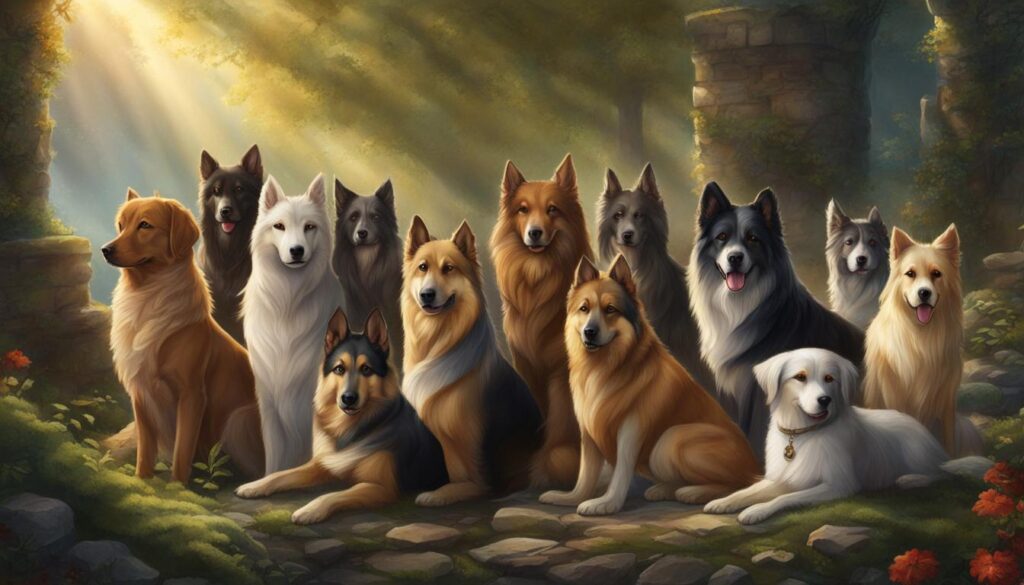
When it comes to the lifespan of ancient dog breeds, several factors come into play, including genetics, size, overall health, and the care provided by their owners. These factors can significantly influence the longevity of these historic and primitive dog breeds.
Genetics play a crucial role in determining the lifespan of ancient dog breeds. These breeds have adapted over thousands of years to survive in their original environments, which has shaped their genetic makeup. The genetic resilience and hardiness of these breeds have allowed them to thrive in harsh conditions and contribute to their long lifespans.
However, genetics alone do not determine lifespan in ancient dog breeds. Other factors, such as nutrition, exercise, veterinary care, and a safe living environment, also play vital roles in ensuring their well-being and longevity.
Nutrition is key to the overall health of ancient breeds. Providing a balanced and nutritious diet that meets their specific needs is essential for supporting their optimal health and extending their lifespan. Similarly, regular exercise tailored to their breed characteristics helps keep them physically and mentally stimulated, promoting their longevity.
“Genetics, nutrition, exercise, veterinary care, and a safe living environment all contribute to the lifespan of ancient dog breeds. By taking care of these factors, we can support their well-being and ensure they live long and fulfilling lives.”
Veterinary care is another crucial factor in promoting the longevity of ancient dog breeds. Regular check-ups, vaccinations, parasite control, and early detection of health issues are essential for maintaining their overall health and detecting any potential problems early on. By addressing health concerns promptly, owners can improve the chances of their ancient dogs living longer and healthier lives.
A safe and nurturing living environment is also vital for ancient dog breeds. Providing them with a secure and stress-free space, both indoors and outdoors, ensures their physical and emotional well-being. Minimizing exposure to potentially harmful substances, avoiding toxic plants, and keeping them away from hazardous situations can significantly impact their lifespan.
By considering these factors and taking appropriate measures, owners can contribute to the longevity and well-being of their historic and primitive dog breeds, ensuring that they continue to be cherished companions for many years to come.
Longevity in Ancient Dog Breeds
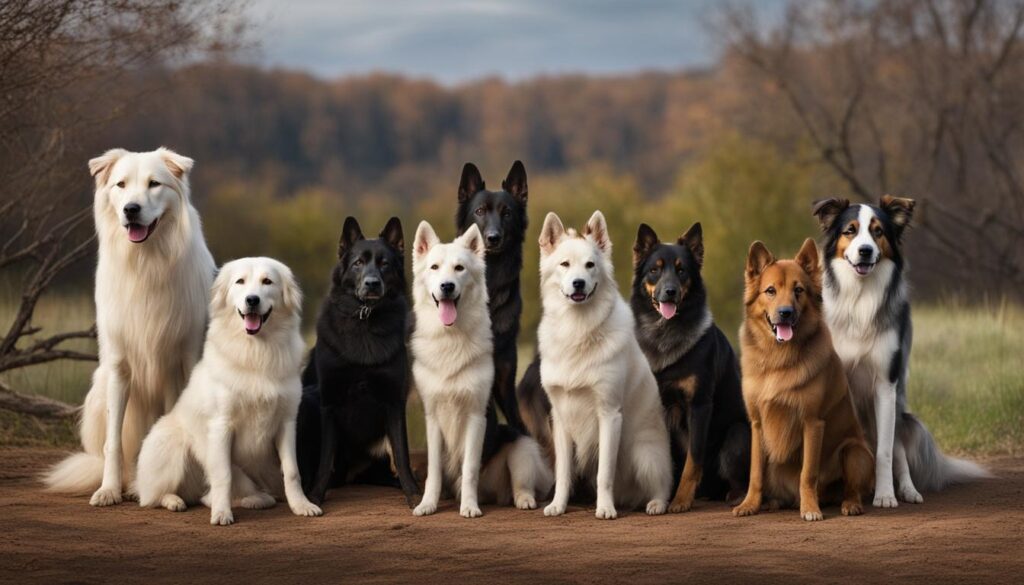
While each ancient dog breed has its own lifespan range, many of these breeds are known for their longevity. Let’s take a look at some fascinating facts about the lifespans of traditional dog breeds.
Basenji
The Basenji, also known as the “barkless dog,” is an ancient breed with an average lifespan of 12 to 16 years.
Shiba Inu
The Shiba Inu, an ancient Japanese breed, typically lives for 12 to 16 years as well. These loyal and independent dogs have captured the hearts of many.
Saluki
The Saluki, one of the oldest known dog breeds, can live for 12 to 14 years. These elegant and graceful dogs were historically prized for their hunting abilities.
Akita
The Akita, originating from Japan, has an average lifespan of 10 to 15 years. Known for their loyalty and quiet dignity, Akitas are revered as symbols of strength and protection.
These examples highlight the remarkable longevity that ancient dog breeds can possess. With proper care, these traditional breeds can provide companionship and joy for many years.
| Traditional Dog Breed | Average Lifespan (Years) |
|---|---|
| Basenji | 12-16 |
| Shiba Inu | 12-16 |
| Saluki | 12-14 |
| Akita | 10-15 |
Enhancing Longevity in Ancient Dog Breeds

To promote longevity in ancient dog breeds, it is crucial to understand their specific needs and provide appropriate care. Regular exercise is essential for keeping them physically and mentally stimulated. These breeds often have high energy levels and require activities that cater to their natural instincts. Additionally, a nutritious diet tailored to their specific requirements is vital.
Regular veterinary check-ups, preventive measures such as vaccinations and parasite control, and early detection of potential health issues are also crucial for their well-being. By taking proactive steps to ensure the overall health and well-being of ancient dog breeds, we can help them lead long and fulfilling lives.
Proper exercise is essential for ancient dog breeds to maintain their physical and mental fitness. Engaging in activities that stimulate their natural instincts helps keep them happy and prevents boredom. Regular walks, playtime, and mental stimulation through puzzles and training sessions are recommended. It is important to find a balance between exercise and rest to prevent exhaustion.
The ancient dog breeds’ diet should be carefully chosen to meet their specific nutritional needs. High-quality dog food, rich in essential nutrients and tailored to their breed, is essential for their well-being. Consultation with a veterinarian can help determine the best diet plan to ensure their longevity.
Regular veterinary check-ups are crucial for monitoring the health of ancient dog breeds. Vaccinations and parasite control are essential preventive measures to protect them from diseases and infestations. Early detection of potential health issues through regular check-ups allows for prompt treatment, ensuring the well-being and longevity of these remarkable breeds.
Celebrating Ancient Dog Breeds and Their Lifespan

Ancient dog breeds offer a unique connection to our shared history with canines. Their longevity is a testament to their resilience and the bond they form with their owners. By celebrating these remarkable breeds and understanding their lifespan, we can ensure they receive the care and love they deserve. Whether you are considering adding an ancient breed to your family or already share your life with one, embracing their heritage and providing them with a fulfilling life experience will enrich both your lives.
These extraordinary breeds have stood the test of time, preserving their distinct characteristics and serving as a window into our past. Their ancient origins make them truly special, and their adaptability to different environments showcases their remarkable genetics and evolution.
When we celebrate ancient dog breeds, we acknowledge their significance and the role they have played in shaping our relationship with dogs. From their historical significance to their unique qualities, these breeds are a treasure worth cherishing.
I believe that ancient dog breeds hold a special place in our hearts. Their timeless presence speaks to the depth of our connection with dogs and highlights the resilience that has allowed these breeds to thrive for thousands of years.
Understanding the lifespan of ancient dog breeds is essential in providing them with the care they need. Each breed has its own lifespan range, and while they tend to have relatively long lives, it is important to recognize any breed-specific health concerns and provide appropriate preventive care.
The bond between ancient dog breeds and their owners is unlike any other. These loyal companions have been by our side for centuries, providing unwavering love and companionship. By celebrating their longevity and embracing their heritage, we ensure that these incredible breeds continue to be cherished and cared for.
| Breed | Average Lifespan |
|---|---|
| Basenji | 12-16 years |
| Shiba Inu | 12-16 years |
| Saluki | 12-14 years |
| Akita | 10-15 years |
Canaan Dogs: A Fascinating Ancient Breed
The Canaan Dog, also known as Kelev K’naani, has its roots in the Middle East, specifically in the region of ancient Canaan. These dogs were initially bred by the ancient Israelites for various purposes, including herding, guarding, and even as war dogs. The Canaan Dog can be traced back over 4,000 years, with evidence of their existence found in ancient artifacts, such as pottery and rock carvings.
Ancient Origins and Versatile Skills
The Canaan Dog’s ancient origins make it a fascinating breed with a rich historical background. The dogs’ close association with the ancient Israelites showcases their versatility in fulfilling various roles, including herding livestock, protecting settlements, and even assisting in military endeavors.
| Characteristics | Description |
|---|---|
| Size | Medium-sized |
| Coat | Short and dense, providing protection against the desert climate |
| Colors | Cream, red, black, and various shades of brown, often with white markings |
| Tail | Bushy and carried curled over the back when excited or alert |
The Canaan Dog’s medium size, combined with its lean and muscular build, enables it to maneuver swiftly across varied terrains. Its short and dense coat provides insulation in harsh desert climates, reflecting the breed’s adaptability to its ancestral environment.
“The Canaan Dog’s ancient origins make it a fascinating breed with a rich historical background.”
This breed’s unique coat colors, including cream, red, black, and various shades of brown, adds to its distinctive appearance. Often adorned with white markings, Canaan Dogs display an array of stunning color combinations.
The Canaan Dog’s bushy tail, carried curled over its back when excited or alert, is one of its most distinguishing features. This tail posture is an instinctive trait that showcases the breed’s heightened state of awareness.
Overall, Canaan Dogs exemplify the resilient and adaptable nature of ancient breeds, making them a captivating addition to any dog lover’s family.
The Canaan Dog’s Characteristics and Appearance

The Canaan Dog is a fascinating ancient breed that possesses unique characteristics and an impressive appearance. As a medium-sized dog, they have a lean and muscular build, reflecting their agility and endurance. With their wedge-shaped heads, almond-shaped eyes, and erect ears, Canaan Dogs exude an alert and intelligent expression, capturing the attention of all who encounter them.
One notable feature of the Canaan Dog is their short and dense coat, which serves as protection against the harsh desert climate that they were historically exposed to. This coat helps them stay comfortable in various weather conditions. Canaan Dogs come in a range of colors, including cream, red, black, and various shades of brown, often accompanied by striking white markings.
A defining characteristic of the Canaan Dog is their bushy tail, which is carried curled over their back when they are excited or alert. This unique tail adds to their visual appeal and serves as a distinctive trait among other ancient breeds.
Wrapping Up
Ancient dog breeds have a captivating allure due to their rich history and unique characteristics. Understanding the factors that influence their longevity allows us to appreciate their heritage and provide them with the best care possible. By celebrating these remarkable canines and nurturing their well-being, we can ensure that they continue to bring joy and companionship for many years to come.
Embracing the legacy of ancient dog breeds is a testament to our admiration for their resilience and the bond they form with their owners. Cherishing their presence in our lives and honoring their longevity through love, care, and admiration is the way to truly appreciate these extraordinary animals.
Ancient dog breeds hold a special place in our hearts, reminding us of our shared history with canines and the immeasurable impact they have had on human civilization. As we continue to learn about and appreciate these unique breeds, we deepen our connection to our collective past and strengthen the bond we share with our loyal companions.
FAQ
What are ancient dog breeds?
Ancient dog breeds, also known as primitive breeds, are those that have been in existence for thousands of years and have changed very little through selective breeding.
Can you provide some examples of ancient dog breeds?
Sure! Some examples of ancient dog breeds include the Basenji, Shiba Inu, Saluki, and Akita. These breeds have their roots in different parts of the world, such as Africa, Japan, and the Middle East.
What factors contribute to the lifespan of ancient dog breeds?
Several factors contribute to the lifespan of ancient dog breeds, including genetics, size, overall health, and the care provided by their owners.
How long do ancient dog breeds typically live?
While each ancient dog breed has its own lifespan range, many of these breeds are known for their longevity. For example, the Basenji has an average lifespan of 12 to 16 years, the Shiba Inu typically lives for 12 to 16 years, the Saluki can live for 12 to 14 years, and the Akita has an average lifespan of 10 to 15 years.
How can I promote longevity in ancient dog breeds?
To promote longevity in ancient dog breeds, it is crucial to understand their specific needs and provide appropriate care. Regular exercise, a nutritious diet, regular veterinary check-ups, and preventive measures such as vaccinations and parasite control are all essential.
What makes ancient dog breeds unique?
Ancient dog breeds offer a unique connection to our shared history with canines. Their longevity is a testament to their resilience and the bond they form with their owners.
What is the Canaan Dog?
The Canaan Dog, also known as Kelev K’naani, is an ancient breed that has its roots in the Middle East, specifically in the region of ancient Canaan. These dogs were initially bred by the ancient Israelites for various purposes.
What are the characteristics of the Canaan Dog?
The Canaan Dog is medium-sized, with a lean and muscular build. They have wedge-shaped heads, almond-shaped eyes, and erect ears. Their coat is short and dense, and they come in various colors. One of their most distinctive features is their bushy tail, which is carried curled over their back when they are excited or alert.
How can I celebrate ancient dog breeds and their lifespan?
Embrace the legacy of ancient dog breeds, cherish their presence in your life, and honor their longevity through love, care, and admiration.


